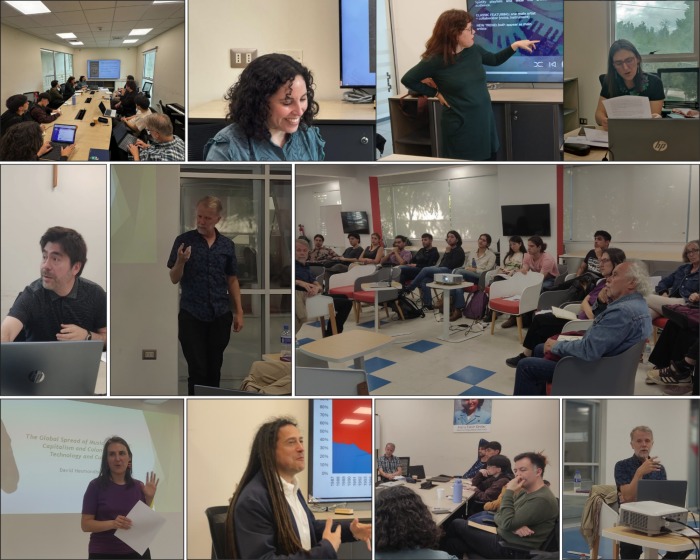David Hesmondhalgh in Viña del Mar: formats and the music industry
British academic David Hesmondhalgh visited Viña del Mar as a guest of CMUS principal investigator Laura Jordán and participated in two events at the Music Institute of the Pontifical Catholic University of Valparaíso, where she teaches. The first was the lecture “The Global Spread of Music Streaming: Capitalism and Colonialism, Technology and Culture,” held in the institute’s library on the afternoon of November 5th. There, the University of Leeds professor addressed the new challenges posed by the music industry in the age of streaming. He noted that the industry perpetuates colonialist and imperialist models employed by record labels, digital companies, and technology owners, highlighting the fact that some regions of the world still lack access to technology compared to the United States or Europe, thus maintaining inequality. The researcher pointed out that one of the new developments is that countries have increased their consumption of local artists in this streaming era. However, he acknowledged that global figures like Taylor Swift and Beyoncé continue to be widely listened to in much of the world. In terms of genres, hip hop continues to predominate, whether from the United States, England, or local sources within each country. David Hesmondhalgh’s lecture was inspired by his book, Music Streaming Around the World (University of California Press, 2025). At the end, Laura Jordán’s students contributed insightful questions to spark a discussion.
Music workshop of the past and present.
On Thursday morning, November 6th, the workshop Materialities, Practices, and Industries of Popular Music began. Eileen Karmy kicked things off with A Playlist of International Protest Songs. Workers’Songbooks of the early 20th century in the Southern Cone which is part of her Fondecyt project, “Popular Songbooks.” The CMUS associate researcher spoke about night schools for workers who took classes with professional musicians and the collective nature of their musical activities. She also explored the adaptations of popular local and foreign music with new lyrics, often featuring protest songs, making them easier to learn.
Next up was Laura Jordán with “Better the Beatles, Come On! Sound, Co-presence, and Epistolary Uses of the Cassette under Dictatorship.” In her presentation, the principal investigator at CMUS explored the tapes that Jonás recorded from Chile for Eduardo Carrasco, who was in exile in France with his group Quilapayún. On these cassettes, the Chilean poet compiled everyday audio recordings, such as street sounds, radio broadcasts (whether song excerpts or news reports), and his own voiceovers. The PUCV professor analyzed these sound collages as the voice itself. This research is part of the Fondecyt project “Cassette Cultures: Technology, Listening, and Participation,” in which Javier Rodríguez, an associate researcher at CMUS, also participates.
Next was Arturo Figueroa, an academic from Finis Terrae University, with his presentation “Discourses and socio-political involvement of Chilean musicians in the music press: the case of indie composers.” In it, he analyzed the political stance of indie singers in Chile from 2005 to 2018 as seen by the local press, whether on current issues such as environmental or feminist causes and their opposition to left- or right-wing conservatism—all from a more emotional perspective. He also found instances of artists or media editorials avoiding these topics. Furthermore, he reviewed music media coverage from the 1960s to the 1990s to explore this same topic, but with musicians from broader musical genres, thus introducing part of his Fondecyt research grant.
Daniel Party took over after a coffee break. The principal investigator from CMUS presented “Gender Representation on Billboard’s Hot Latin Songs Chart (1987-2024),” exploring this category of the awards, which began in the 1980s and has been measured in various ways. This is due to changes in distribution formats and consumption patterns. This Latin chart encompasses a wide variety of musical styles, from salsa to Mexican corridos. In his research, the PUC academic found several periods when female representation was significantly lower and almost nonexistent, including 21 weeks in which no songs by women appeared on the chart.
Finally, journalist and independent researcher Macarena Lavín presented “Singing for the Algorithm: A Look at the Platformization Process of the Chilean Music Industry,” a project she co-investigated for a Music Fund. Lavín, who also manages communications for CMUS, explored perspectives on Spotify’s use by the current music ecosystem (content aggregators, record labels, and artists), including monetization, emerging problems (such as anxiety and low platform payouts), and a new way of releasing songs. This was illustrated with various testimonials from individuals interviewed for the study led by Arturo Arriagada (UAI).
After the presentations there was a fruitful dialogue guided by the researchers and comments and questions from David Desmondhalgh.


